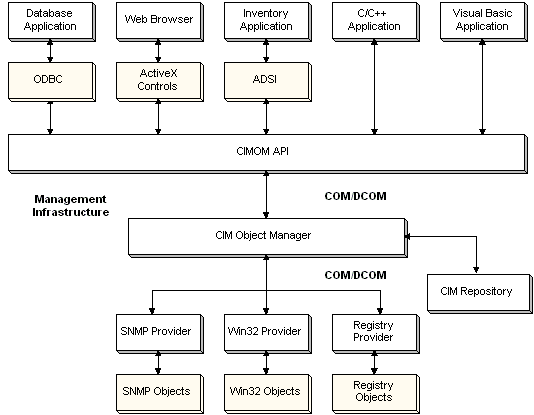
[This is preliminary documentation and subject to change.]
The architecture of the Web-Based Enterprise Management (WBEM) technology consists of the following components:
Management applications are Windows applications or Microsoft® Windows NT® services that process or display data from managed objects. A management application can perform a variety of tasks such as measuring performance, reporting outages, and correlating data.
Managed objects are logical or physical enterprise components. Managed objects are modelled using the CIM and accessed by management applications through CIMOM. A managed object can be any enterprise component, from a small piece of hardware such as a cable to a large software application such as a database system.
Providers use the CIMOM API to supply CIMOM with data from managed objects, to handle requests on behalf of management applications, and to generate notifications of events. The WBEM SDK supplies several standard providers, such as a Registry Provider for accessing information from the system registry, and a Microsoft Windows NT Event Log Provider for receiving notifications of Windows NT events and access to the information stored in the Windows NT event log. Third-party vendors can create custom providers to interact with managed objects specific to their environment.
The management infrastructure consists of CIMOM for handling the communication between management applications and providers and the CIMOM repository for storing static data. Applications and providers communicate through CIMOM using a common programming interface (CIMOM API) which supplies such services as event notification and query processing. The CIMOM API is available in several programming languages, such as C, C++, Microsoft® Visual Basic®, and Java™.
The CIMOM repository holds static management data. Static data is data that does not regularly change. WBEM also supports dynamic data, or data that must be generated on demand because it is frequently changing. Data can be placed in the CIMOM repository by by CIMOM, network administrators, or third-party developers using either the Managed Object Format (MOF) language and its compiler or the CIMOM API.
The following diagram shows the relationship between the components in the WBEM technology. At the top of the diagram are examples of management applications. Some of these applications access the CIMOM API directly to interact with CIMOM and the CIMOM Repository; some use a variety of access methods. The applications in the diagram use Open Database Connectivity (ODBC), the Hypertext Markup Language (HTML), and the Active Directory Services Interface (ADSI) to make management requests.
At the bottom of the diagram are examples of managed objects and their corresponding providers. Again there is a variety of access methods used for communication.
The protocol used for communication between local and remote components is Distributed COM (DCOM). 